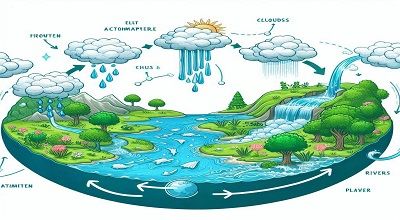A Plan on Water Cycle
Planning for the water cycle involves understanding and managing the various stages through which water moves on Earth—evaporation, condensation, precipitation, and runoff. Here’s a plan to better understand and manage the water cycle:
1. Education and Awareness
- Develop educational programs to raise awareness about the water cycle among students, communities, and businesses.
- Use various media channels, workshops, and events to communicate the importance of water conservation and sustainable water use.
2. Data Collection and Monitoring
- Invest in technology and infrastructure for accurate monitoring of precipitation, evaporation, and water levels in rivers, lakes, and reservoirs.
- Collaborate with meteorological agencies and environmental organizations to collect and analyze data on weather patterns and water availability.
3. Infrastructure Development
- Build and maintain efficient water supply and distribution systems to ensure water reaches areas in need.
- Invest in wastewater treatment plants to recycle and reuse water, reducing the demand for freshwater sources.
4. Land Use Planning
- Implement land use practices that promote water infiltration and reduce surface runoff, such as green roofs, permeable pavements, and conservation of natural vegetation.
- Establish buffer zones along water bodies to protect against pollution and erosion.
5. Agricultural Practices
- Encourage and educate farmers on sustainable irrigation methods, such as drip irrigation, to minimize water wastage.
- Promote crop rotation and other water-efficient agricultural practices to reduce the overall water footprint of farming.
6. Climate Change Adaptation
- Develop strategies to adapt to the impacts of climate change on the water cycle, such as changes in precipitation patterns and increased frequency of extreme weather events.
- Invest in water storage facilities and infrastructure capable of withstanding changing climate conditions.
7. Community Engagement
- Engage local communities in water conservation efforts through community-based programs.
- Establish community gardens, rainwater harvesting systems, and other initiatives to involve citizens in sustainable water practices.
8. Legislation and Policy
- Develop and enforce water management policies that promote conservation, efficient water use, and protection of water resources.
- Integrate water conservation measures into building codes and land development regulations.
9. International Cooperation
- Collaborate with neighboring countries and international organizations to manage transboundary water resources effectively.
- Share data, technology, and best practices to address water-related challenges on a global scale.
10. Research and Innovation
- Invest in research and development to explore new technologies for water purification, desalination, and sustainable water management.
- Foster innovation in water conservation practices and technologies through partnerships with research institutions and the private sector.
11. Emergency Preparedness
- Develop contingency plans for water scarcity and flooding events, considering both short-term and long-term strategies.
- Establish early warning systems for extreme weather events that could impact the water cycle.
12. Public Outreach and Communication
- Regularly communicate updates on water availability, conservation efforts, and the importance of individual actions in preserving water resources.
- Use social media, community forums, and other channels to maintain an ongoing dialogue with the public.
Final Words
Implementing this comprehensive plan involves the collaboration of government agencies, communities, businesses, and individuals to ensure sustainable water management practices for the benefit of current and future generations.
